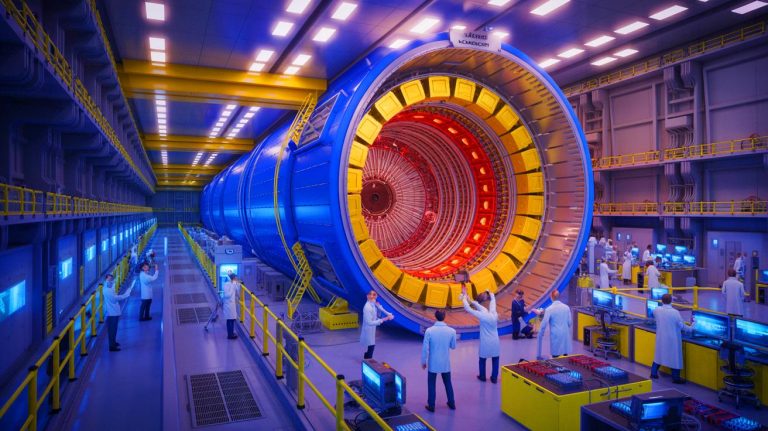| IN A NUTSHELL |
|
In the ever-evolving world of particle physics, the High-Luminosity Large Hadron Collider (HL-LHC) represents a monumental leap forward. Engineers at CERN are on the brink of completing a pivotal facility that is critical for this next-generation upgrade, which aims to significantly enhance the discovery potential of the world’s most powerful particle accelerator. As a full-scale replica of the new segments designed to operate at an extremely cold -456°F, this facility marks a crucial milestone. The intricate process involves precise positioning of components weighing up to 20 tons, utilizing advanced handling equipment. This development promises to unlock new insights into fundamental physics.
Boosting Delivery Potential with Advanced Magnets
The HL-LHC project aims to increase the accelerator’s luminosity, or the number of particle collisions, by a factor of ten. This dramatic enhancement will allow physicists to probe known particles, such as the Higgs boson, with unprecedented accuracy and propel the quest for new physics that could elucidate mysteries like dark matter. This leap forward is driven by novel superconducting quadrupole magnets, crafted from an innovative niobium-tin alloy. These magnets are capable of generating a magnetic field of 11.3 tesla, a significant upgrade from the existing 8.3-tesla magnets.
To achieve the necessary superconductivity, these 20-ton magnets must be cooled with superfluid helium to a temperature of 1.9 Kelvin, colder than deep space. The current test assembly, referred to as the “IT String,” is essential for ensuring that all components function cohesively under these extreme conditions before their eventual integration into the main LHC tunnel. This endeavor is not just a technological challenge but a gateway to a new era of particle physics exploration.
Strategic Testing and Training
The test stand serves as a crucial platform for evaluating how various circuits perform collectively under realistic conditions. According to Marta Bajko, head of the IT String project, this phase allows for the fine-tuning of installation procedures, preparing for their eventual commissioning during the LHC’s third long shutdown. The assembly’s technical complexity is immense, involving a power supply line carrying over 100,000 amperes and approximately 70 intricate interconnections using specialized brazing techniques to ensure the continuity of the superconducting circuits.
This testing phase is not only about technical validation but also about training. It provides teams with the opportunity to gain practical experience in a controlled environment before transitioning to the main LHC tunnel. As the installation and validation work continues, the team is gearing up for the complex cooling process, with the first power-up of the magnets expected by year-end. The success of this phase is crucial for advancing the HL-LHC project, which aims to push the boundaries of particle physics.
Understanding the Importance of Superconductivity
Superconductivity is at the heart of the HL-LHC’s enhanced capabilities. By cooling the magnets to a frigid temperature of -456°F, the facility leverages the power of superconductivity to conduct electricity without resistance. This remarkable phenomenon allows the magnets to generate significantly higher magnetic fields, which are essential for focusing particle beams more tightly. The result is a higher luminosity, translating to more collisions and more data for physicists to analyze.
Understanding superconductivity not only aids in technological advancements but also contributes to our fundamental comprehension of physics. The HL-LHC’s ability to maintain superconductivity under extreme conditions is a testament to human ingenuity and scientific progress. This capability is indispensable for achieving the project’s ambitious goals, including the potential discovery of new particles and forces of nature.
The Path Forward: Challenges and Opportunities
As the HL-LHC project progresses, it faces numerous challenges, including the technical demands of maintaining superconductivity and the logistical complexities of component installation. However, these challenges are also opportunities for innovation and learning. The project exemplifies the collaborative spirit of international science, with experts from around the world contributing to its success.
The HL-LHC promises to open new frontiers in particle physics, offering insights that could reshape our understanding of the universe. As the project moves closer to completion, it invites us to ponder the possibilities that lie ahead. What new discoveries might emerge from this cutting-edge facility, and how will they transform our knowledge of the cosmos?
Did you like it? 4.5/5 (28)







Wow, -456°F! How do they manage to keep those magnets so cold? 🥶
Is anyone else worried about what could happen if something goes wrong with these powerful magnets? 🤔
Sounds like something out of a sci-fi movie! What are the practical applications of this research?
Why does the HL-LHC need to be so much more powerful than the previous collider?